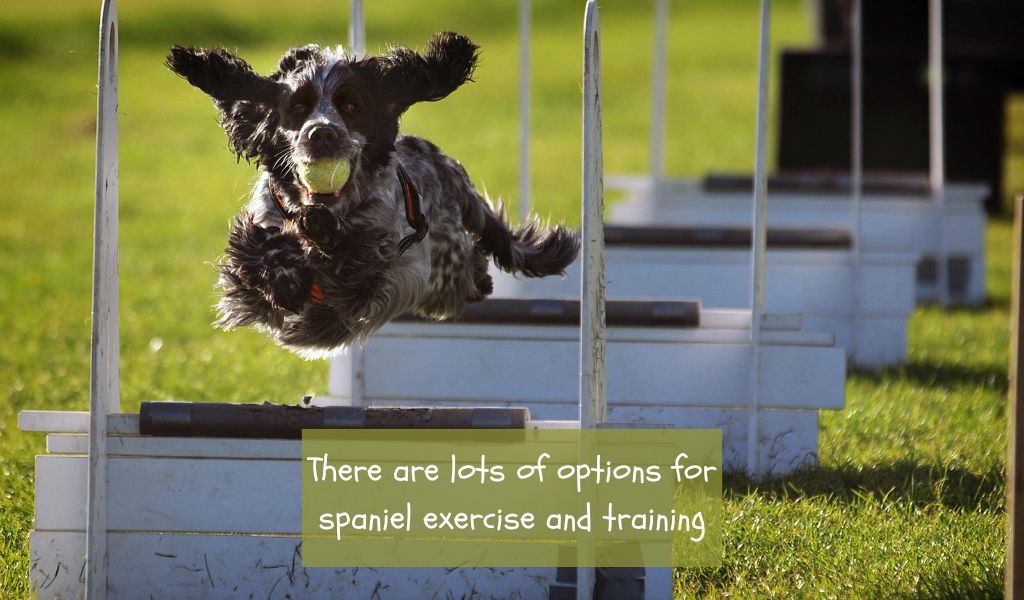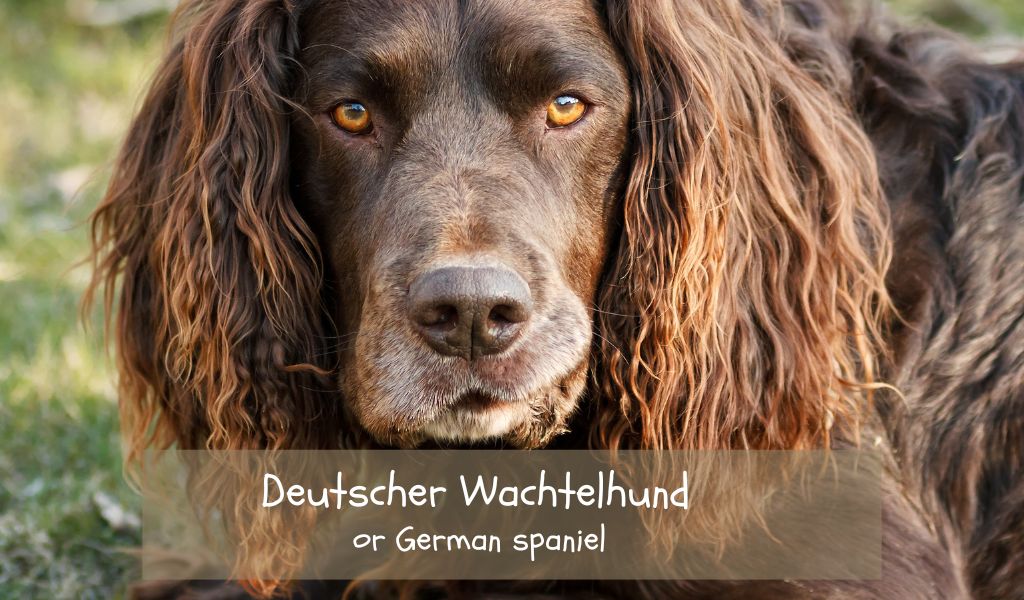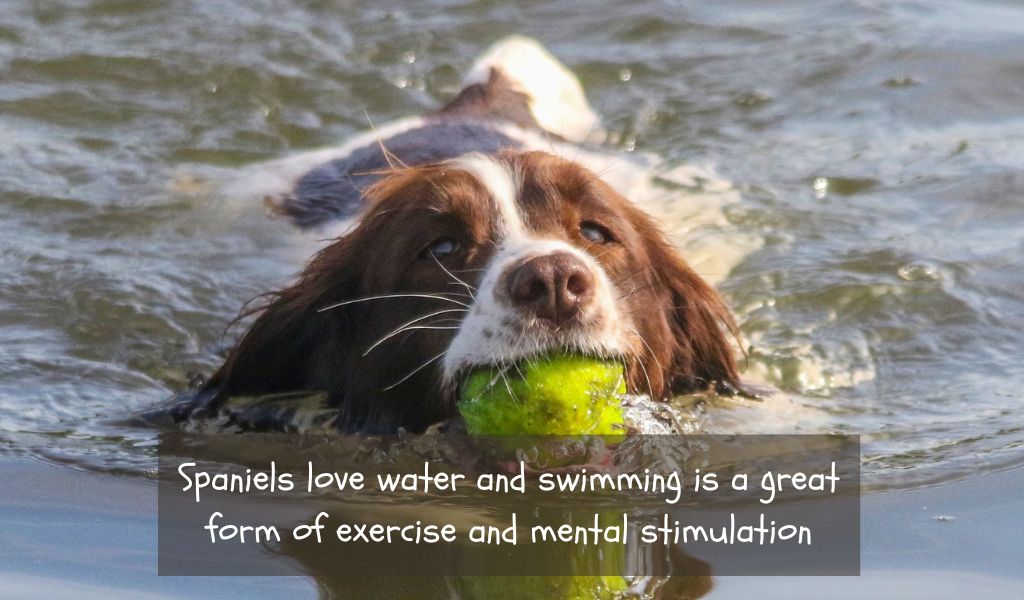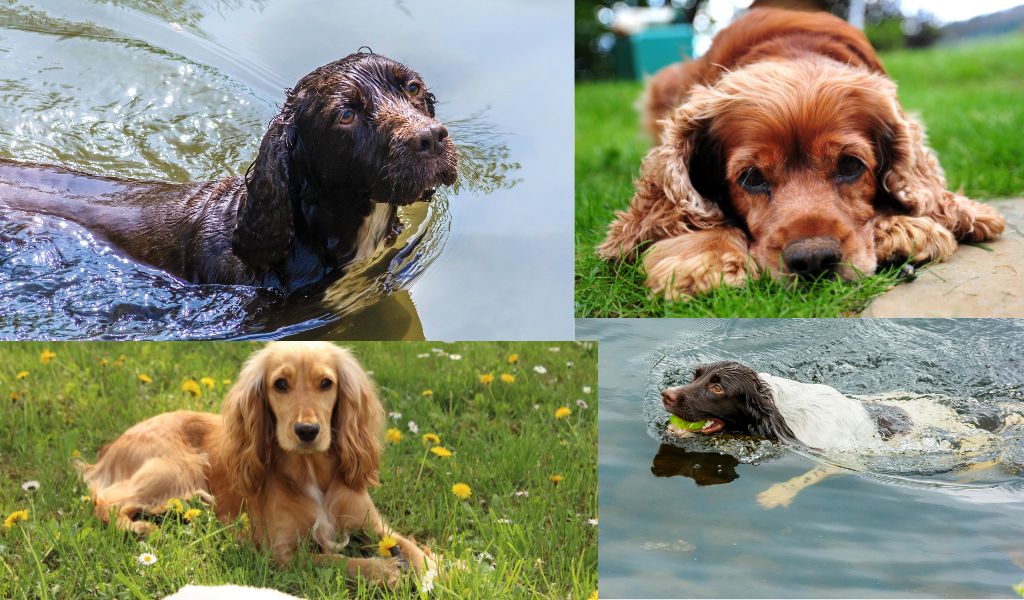Do you want a loyal and loving companion who loves to be active? If so, then consider bringing home a spaniel. Spaniels are an intelligent breed of dog that make great family pets.
They have been cherished by people for centuries due to their sweet nature and friendly demeanour.
With the right training, they can also become excellent working partners or even therapy dogs.
If you take time to understand a spaniel and provide him with exercise, stimulation and take care of his basic needs then, yes, spaniels are easy dogs.
Overview of well known spaniel breeds
Cocker Spaniel: Cocker Spaniels are friendly, playful, and affectionate dogs that are known for their long, silky ears. They come in a variety of colours, including black, golden, and red.
English Springer Spaniel: English Springer Spaniels are active, energetic dogs that are often used as hunting companions. They have a thick, water-resistant coat that can come in black and white, liver and white, or black and tan.
Welsh Springer Spaniel: Welsh Springer Spaniels are similar in appearance to English Springer Spaniels, but they have a slightly different body type and are generally smaller. They have a thick, wiry coat that comes in a range of colours, including liver and white and red and white.

Clumber Spaniel: Clumber Spaniels are a large, heavy-boned breed that were originally bred for hunting in dense forests. They have a gentle, good-natured personality and a thick, dense coat that comes in a creamy white colour.
American Cocker Spaniel: American Cocker Spaniels are smaller than their English Cocker Spaniel counterparts and are known for their cheerful, outgoing personality. They come in a wide range of colours, including black, buff, and red.
Sussex Spaniel: Sussex Spaniels are a rare and endangered, slow-moving breed that were originally bred for hunting in dense cover. They have a friendly, good-natured personality and a thick, dense coat that comes in a rich liver colour.
Field Spaniel: Field Spaniels are a medium-sized breed that were originally bred for hunting and are similar in size to the English Cocker spaniel. They have a distinctive black and tan or liver and tan coat.
Irish Water Spaniel: Irish Water Spaniels are a large, athletic breed that were originally bred for retrieving game from water. They have a curly, tightly woven, liver-coloured coat and a unique “rat tail.”
Brittany Spaniel: Brittany Spaniels are a high-energy breed that were originally bred for hunting in France. They have a short, dense coat that comes in a variety of colours, including orange and white and liver and white. The Brittany is a popular dog in the USA, less so in the UK and other countries.
Cavalier King Charles Spaniel: Cavalier King Charles Spaniels are a small, affectionate breed that are known for their love of people. They have a silky, long coat that comes in a range of colours, including black and tan, ruby, and tri-colour.
There are many varieties of spaniel
There are many different breeds of dogs that define as a type of ‘spaniel’. Most are bred for working but there are several that are simple lap dogs, bred for companionship.
Less common breeds of spaniel include:
The Tibetan spaniel
The Russian spaniel
German Spaniel (Deutscher Wachtelhund)
Papillon and Phalène Spaniels (Épagneul nain continental)
Characteristics of a spaniel
Spaniels are loyal, affectionate, and outgoing.
While all spaniels share some common traits, each breed has its own unique characteristics that make it special.
Physical Characteristics
Spaniel breeds typically have long, curly coats that come in a variety of colours depending on the breed.
Most spaniels have floppy ears and droopy eyes that give them an endearing appearance.
Typically, they have strong legs with webbed paws which makes them great swimmers.
Depending on the breed, they can range in size from small to large.
Personality Traits
Spaniels are known for their intelligence and trainability as well as their natural friendliness and enthusiasm for life.
They love being around people and enjoy playing games or going for walks outside—especially when there is water involved.
With proper training and socialization, spaniels can make wonderful family pets who will bring joy to your home for years to come.
Activity Level
Spaniels were originally bred as working dogs and many still retain their instinctive desire to run, jump, and play outdoors.
If you choose to add a spaniel to your home do not be surprised if he or she loves spending time running around in your house and garden.
Most spaniels require regular exercise to stay healthy and happy—so plan on taking your pup out for daily walks or playtime sessions in the park or beach if possible.
Pros and Cons of owning a spaniel
What should you know before you decide to bring a spaniel into your home?
Let’s break down the pros and cons of owning a spaniel.
Pros of owning a spaniel
The first thing to know about spaniels is that they are extremely loyal and loving animals.
They bond closely with their owners, making them great companions for families or single people alike.
They are also very intelligent and easy to train, making them great pets for first-time owners.
Spaniels are also active dogs due to their hunting heritage, which means they need plenty of exercise and activity in order to stay healthy and happy.
This makes them ideal companions for those who love outdoor activities such as hiking or running.
Cons of owning a spaniel
Spaniels can also be quite vocal animals, which may not be ideal for those living in close quarters such as apartments or other areas with lots of close neighbours.
Additionally, since they are bred for hunting purposes, they can have an independent streak that makes it more difficult for owners to keep track of where their dog is at any given moment.
Finally, spaniels require lots of grooming due to their long fur coats, which means that regular brushing sessions need to be scheduled in order for them to stay comfortable and healthy.
Training tips for spaniels
Training your spaniel is important for a number of reasons.
Not only will it help you set boundaries and expectations for your pet, but it will also help to create a stronger bond between you and your pet.
Spaniels are intelligent and relatively easy to train, let’s take a look at how you can train them effectively and efficiently.

Training from an early age
It’s best to start training as soon as possible with any dog breed, but especially with spaniels.
The sooner you begin training, the easier it will be for your pet to learn commands and understand boundaries.
It is important that you remain consistent when training and that you do not get frustrated if they don’t understand right away or fail to obey commands.
If they don’t perform correctly during a session, simply re-direct their behaviour and try again.
Over time, they will become more familiar with commands and better able to control their behaviour when asked.
Positive reinforcement
Positive reinforcement is key when teaching your spaniel new behaviours or tricks.
Each time they successfully complete a command or trick, reward them with verbal praise or treats (or both).
This will encourage them to continue following directions, rather than punishing bad behaviour which may lead to confusion or fear in your pet.
Consistency is key here too, ,if you give a treat every time they do something correctly but then suddenly stop giving treats out of nowhere, this could confuse them and make them less likely to obey commands in the future.
Keep training sessions short
Spaniels are smart dogs who learn quickly–but that doesn’t mean you should draw out training sessions for hours on end.
10-15 minutes is usually enough time for a single session so try breaking up commands into smaller chunks throughout the day instead of trying to cram everything into one long session at once.
This will keep both you and your dog from getting bored or frustrated during each session.
Plus it gives you more opportunities throughout the day to reward good behaviour and build up positive reinforcement habits over time.
With patience, dedication, and consistency on your part your spaniel will soon be responding reliably while creating an even stronger bond between the two of you.

Common health issues with spaniels
As with all breeds there are some health issues that are more common in spaniels than others.
It’s important to be aware of these potential issues so that you can keep your pup as healthy as possible.
Let’s look at some of the most common health problems in spaniels.
Ear Infections
Ear infections are one of the most common health problems facing spaniels.
This is because their ears tend to be longer and droopier than other breeds, which makes them more prone to collecting dirt and debris.
To help prevent ear infections, make sure that you keep your dog’s ears clean by regularly wiping them out with a damp cloth or cotton swab.
Additionally, it’s a good idea to check your dog’s ears for any signs of inflammation or discharge periodically.
If you do notice any symptoms of an ear infection, take your dog to the vet as soon as possible.
One of the biggest causes of problems for a spaniel’s ears are grass seeds. These types of seeds are sharp and can become lodged inside your dog’s ears, resulting in discomfort and infection. Always check your spaniel’s ears after a walk in areas where grass is in seed.
Skin Issues
Spaniels also tend to suffer from skin issues such as allergies or dryness due to their thick coats and sensitive skin type.
In order to help prevent skin problems from occurring in your spaniel, make sure that you bathe him regularly (1-2 times per month) using a mild shampoo specifically designed for dogs with sensitive skin types.
Additionally, feeding your pup a balanced diet full of healthy fats and proteins will help keep his skin hydrated and supple while also providing essential vitamins and minerals for overall wellbeing.
Eye Problems
Another common issue among spaniels is eye problems such as conjunctivitis or dry eye syndrome due to their protruding eyes.
To help reduce the risk of developing these types of issues, make sure that you regularly check your pup’s eyes for any signs of redness or discharge—you may even want to consider having him examined annually just in case there are any underlying issues present that need addressing sooner rather than later.
Due to the way that they charge around, spaniels can incur eye injuries, which, at times can need veterinary treatment. As with ears, in my experience with spaniels, grass seeds are among the worst. They can scratch eyes and can become lodged within the eye. Always check your dog’s eyes after walking through long grasses.
Grooming requirements for spaniels
If you’re the proud owner of a spaniel, it’s important to understand the grooming requirements for your pup.
Brushing your spaniel’s coat
The most common type of coat on a spaniel is medium to long length fur, which requires frequent brushing to prevent mats and tangles.
You should brush your pet at least once or twice a week, with special attention paid to areas around their collar and behind their ears.
Make sure to use the right kind of brush, brushes that can remove dead hair are best suited for this type of coat as they can penetrate deep into the fur without causing discomfort.
When brushing, be gentle but firm in order to work out any knots or mats that may have formed.
Bathing your spaniel
Spaniels need bathing every few months in order to maintain a healthy coat and remove any dirt or debris that may have become entangled in their fur during playtime outside or other activities.
When bathing your pet, make sure to use an appropriate shampoo designed specifically for dogs; human shampoo can be too harsh for canine skin and could cause irritation or dryness if used too often.
Be sure to rinse thoroughly after washing in order to avoid any residue being left behind on their coat which could lead to skin irritation later on down the line.
Nail trimming & ear cleaning
In addition to regular brushing and bathing, it is important to trim your pet’s nails periodically in order to keep them from becoming overgrown which can be painful for them when walking or running around outside.
It is also important to clean out your pet’s ears regularly as debris can accumulate over time leading to potential infections if not taken care of appropriately.
Use cotton swabs dampened with water (or an ear cleaner specifically designed for pets) when cleaning out the inner folds of their ears in order reduce risk of damage or infection.
Activities to enjoy with your spaniel
Spaniels are intelligent and active dogs that need plenty of exercise and stimulation.
Luckily, there are a wide variety of activities that make playing with your spaniel both fun and stimulating.
Let’s explore some of the most popular activities to enjoy with your spaniel.
Fetch Games
One of the classic activities for any dog is fetch, and spaniels are no exception.
This activity is great for exercising both your dog’s body and mind.
Fetch also gives your pup a chance to practice their obedience skills.
When teaching your pup to fetch, use positive reinforcement and reward them with treats or praise when they bring the ball back to you.
You can also try other variations on fetch such as tug-of-war, which will help strengthen the bond between you and your pup even more.
Agility Training
Agility training is a great way to keep your pup occupied while still getting in some exercise—and it’s a lot of fun too.
This activity involves running through obstacle courses designed specifically for dogs; these obstacles include hurdles, tunnels, weave poles, A-frames, teeter boards, jumps, and more.
Agility training helps improve coordination in dogs and encourages them to think on their feet while having fun at the same time.
Plus, it provides an opportunity for bonding between you and your pup since you must act as their coach during the course.

Swimming
Spaniels love water and swimming is one of their favourite activities.
Swimming provides an excellent source of low-impact exercise for dogs—it works nearly all muscle groups at once without putting too much strain on joints or bones.
Swimming also helps boost cardiovascular endurance as well as mental functioning, plus it’s just plain fun.
Just make sure that when swimming with your pup you always stay close by so that they feel safe while in the water.
Walks & Running
Walks and runs are essential for your spaniel’s health and wellbeing.
Not only does it give them an opportunity to explore the outdoors, it also provides physical exercise and mental stimulation.
Aim for 20-30 minutes of activity a day at least five times a week in order to keep your pup healthy and fit.
During walks, be sure to stay away from busy roads or areas with loud noises as this could startle or scare your pet.
Also, make sure that they wear their collar at all times in case they get lost so they can be identified easily by rescuers or vet clinics.
Toys
There are a variety of toys on the market specifically designed for spaniels to play with – from rope balls to tennis balls – so be sure to grab one that is safe and durable enough for hours of playtime with your dog.
Additionally, you can even make homemade toys by using items around the house such as old socks filled with bit of dog food, cheese or treats.
Spaniels are intelligent, active dogs and therefore need plenty of exercise and stimulation.
From fetch games to agility training to swimming and walks, there is no shortage of activities that will help keep your spaniel healthy, fit and happy.
Additionally, providing toys for them to play with can also be beneficial not only in terms of physical activity but mentally as well.
With the right amount of care and attention, you’ll be able to enjoy spending time with your faithful companion while they live a long and fulfilling life by your side.




